#vegan recipe
Text
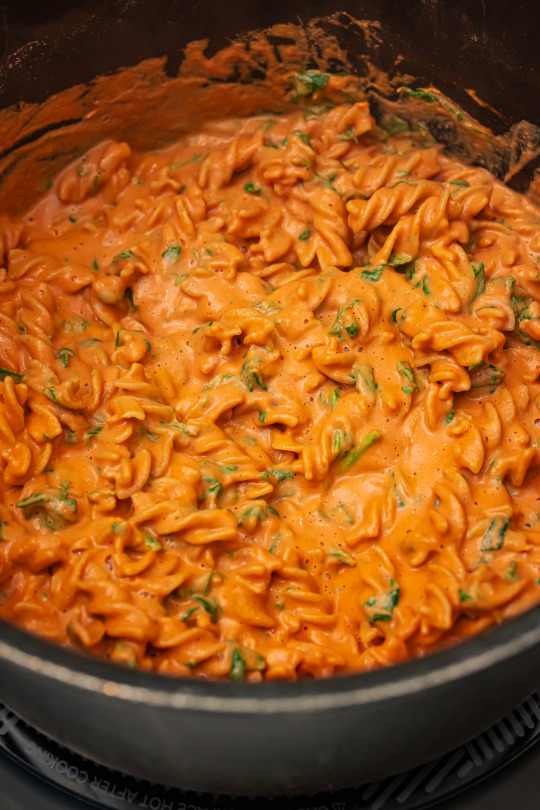

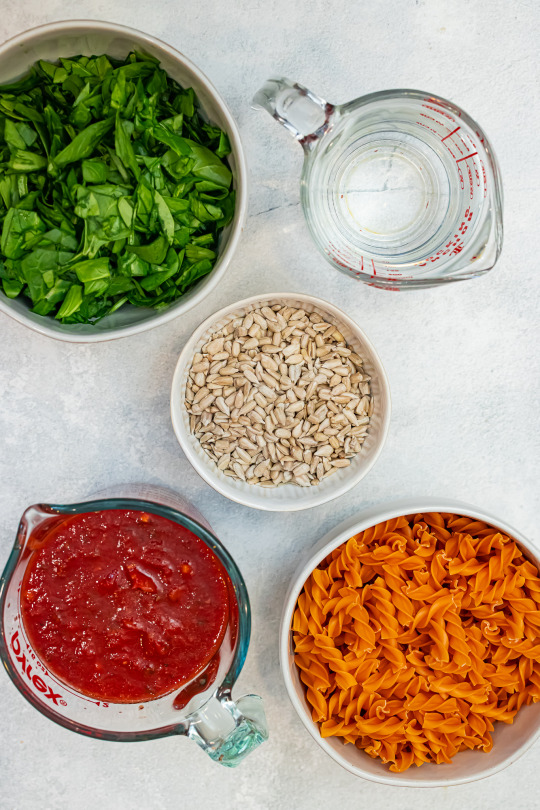
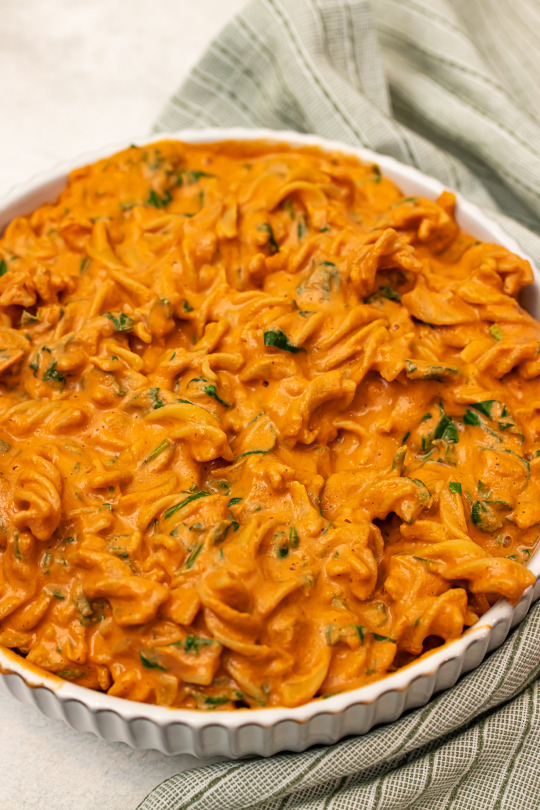
Vegan Protein Pasta
#vegan#food#vegetarian#vegan food#veganism#recipe#plantbased#vegan recipe#dinner#vegan dinner#vegan pasta#protein#protein meals
23 notes
·
View notes
Text

Cheeseburger Spring Rolls
#eatfigsnotpigs#savoury#snacks#lunch#dinner#spring rolls#egg rolls#recipe#recipes#food#vegan#vegetarian#plantbased#th1nsp1ration#thin$po#foodlover#food lover#foodie#foodies#foodporn#food photography#veganism#vegan food#vegan foodporn#vegan recipes#vegan recipe#go vegan#veganrecipes#what vegans eat#veganfood
19 notes
·
View notes
Text

[ID: A greyish brown stew presented alongside flatbread, red pepper paste, green peppers, and carrot sticks. End ID]
سماقية / Summagiyya (Gazan stew with chard, chickpea, sumac, and 'lamb')
Summagiyya (سُمَّاقِيَّة; also translitered "sumagiyya", "sumaghiyyeh" or "sumaqiyya") is one of the signature dishes of the Gaza strip, in particular Gaza City. It consists of lamb, chard, and chickpeas in a sumac-infused broth; savor and zest is added by a dagga of dill seeds, garlic, and peppers, and nutty depth by a generous drizzle of red tahina. The resulting stew is thick, earthy, and slodgily grey (due to the green chard and red sumac)—it also has the characteristic sourness of much Gazan cuisine.
Summagiyya is most often prepared during holidays, especially Eid al-Fitr; it's an excellent make-ahead dish for these occasions, since it's even better once its flavors have had time to meld and mellow overnight. It is served cold alongside fresh vegetables, and eaten by using flatbread to scoop up each bite. This recipe provides a spiced seitan recipe to replace the lamb, but you may also use any lamb or beef substitute of your choice.
Today, summagiyya is often prepared with Israeli white tahina, as decades of punitive import laws, taxes, and restrictions have enforced Palestine's status as a consumer, rather than an producer, of food products. Israeli tariffs on, and confiscations of, Palestinian goods have forced those tahina factories that survived to import sesame seeds rather than using locally grown crops, even as they export the best of their product to Israel. The dubbing of foods such as tahina and hummus as culturally "Israeli" cuisine works to hide this exploitative relationship, and cement an Israeli national identity through the subsuming and erasure of Palestinian existence. It is for this reason that Emad Moussa writes that Palestinian cuisine has a role in "protecting against a people's very extinction."
Medical Aid for Palestinians (MAP) has put out an urgent call for donations to provide medical supplies to Palestinian hospitals when supply lines reopen. Also contact your representatives in the USA, UK, and Canada.
Ingredients:
For the soup:
500g (2 large bunches) chard (شلق), diced
80g Levantine sumac berries (Rhus coriaria)
1/2 cup soaked and boiled chickpeas, mostly cooked (40g dry / scant 1/4 cup)
1/4 cup red tahina
1/2 cup (60g) all-purpose flour
1 large yellow onion
1/4 cup olive oil
1 tsp kosher salt
2 cardamom pods (optional)
2 allspice berries (optional)
More olive oil, to fry
Sumac berries can be found in the spice section of a halal grocery store. If you're unable to locate whole berries, pre-ground will do.
For the dagga:
1 1/2 Tbsp dill seeds
5 cloves garlic
1/2 green cubanelle pepper
2-3 dried red chilis (optional)
1/2 tsp black pepper
1/4 tsp cumin
Dill seeds may be found at a halal, south Asian, or speciality European grocery store. They are commonly used in Indian food and as a pickling spice. At a south Asian grocery store they may be labelled soyo, suva, shepu, or savaa.
For the lamb:
1 cup (120g) vital wheat gluten, aka gluten flour
1/2 Tbsp ground sumac
1/2 tsp ground caraway
1 tsp onion powder
1 tsp Palestinian 7-spice
1/2 tsp garlic powder
1/2 tsp sea salt
1/2 tsp ground black pepper
1/2 tsp ground cumin
1/2 tsp ground aniseed
1/2 tsp turnermic
1 tbsp olive oil
1/2 tsp soy sauce
1 tsp miso paste
2 cloves garlic, grated
2 tsp pomegranate molasses
1 Tbsp white or red tahina
About 1/2 cup vegetarian 'beef' stock from concentrate, or vegetable stock
Pomegranate molasses is simply pomegranate juice that has been reduced to a thick consistency. It may be found in the sauces section of a halal grocery store.
Instructions:
For the soup:
1. Soak dried chickpeas in cool water overnight, or in just-boiled water for an hour. Drain and re-cover with water, and boil for 30-45 minutes, until almost fully cooked. Drain and set aside.
2. Simmer sumac seeds in enough water to cover by a couple inches for about an hour, until the water is dark red. Blend the seeds and water together, then strain the mixture through a cheesecloth.
If you're using ground sumac, skip the blending step. Use a cheesecloth or very fine metal sieve (such as one intended for brewing tea) to remove the ground spice from the water.
3. Whisk the flour into the sumac-infused water.
For the lamb:
1. Combine all dry ingredients in a large mixing bowl. Add wet ingredients other than stock and stir briefly. Add enough stock to produce a soft, smooth dough.
2. Knead by hand on a clean surface, or put in a stand mixer with paddle attachment on medium-low, for about 5 minutes. You should see stringy strands begin to form in the dough.
3. Allow to rest, covered, for 5-10 minutes to encourage gluten formation. Knead for another 3 minutes. Do not over-knead.
4. Tear the dough into bite-sized pieces.
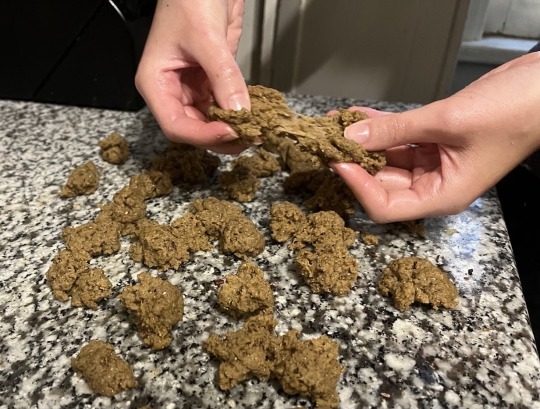
Stringy seitan being pulled apart into pieces.
You may also shape the dough into a slab and cube it with a sharp knife—the lamb or beef used in summagiyya is usually cubed—but I prefer the texture of torn seitan to sliced.
5. Steam the seitan pieces for 10 minutes in a bamboo steamer or using a metal steamer basket. Place the bamboo steamer in the bottom of a wok and cover its base by about 1/2" (1 cm), then raise the heat to boil the water; lower the heat to keep the water at a simmer. If using a steamer basket, place it over the opening of a pot containing a couple inches of water and bring it to a simmer. Start the timer when the water begins simmering.
6. Heat olive oil on medium-high and sear the steamed seitan pieces, turning as necessary, until deeply browned on all sides. Set aside.

Fried seitan pieces.
You can save a step here by searing the raw seitan, then returning it to the pot after you've fried the onions to simmer it rather than steaming. I found that this produced a mushier texture.
For the dagga (دقة):
1. Grind cumin and black pepper thoroughly in a mortar and pestle, then add dried red pepper and dill seed and crush coarsely. Add green sweet pepper and garlic and pound until a coarse mixture forms.
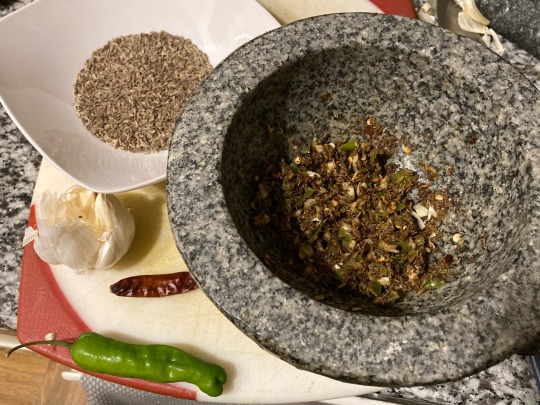
Dill seeds, green sweet pepper, garlic, and dried red chili on a cutting board, alongside dagga in a large granite mortar.
You may also use a spice mill or food processor.
To assemble:
1. Chop the onion. Wash the chard and slice it thinly in one direction; turn it ninety degrees and slice thinly again.
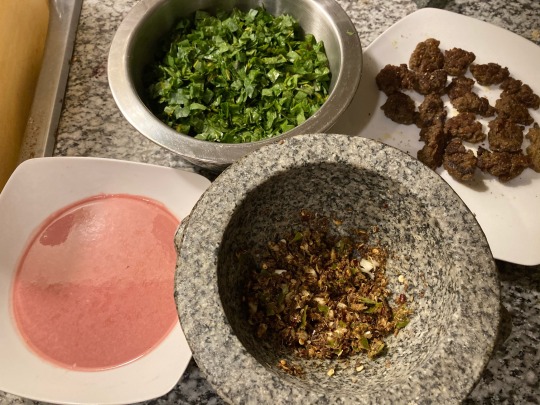
Diced chard, fried seitan, dagga, and sumac-infused water with flour.
2. In a large pot, heat a couple tablespoons of olive oil on medium. Fry chopped onion, cardamom pods, and allspice berries for a minute until fragrant. Add half of the dagga and fry until fragrant.
3. Add chard and fry, mixing often, until wilted.
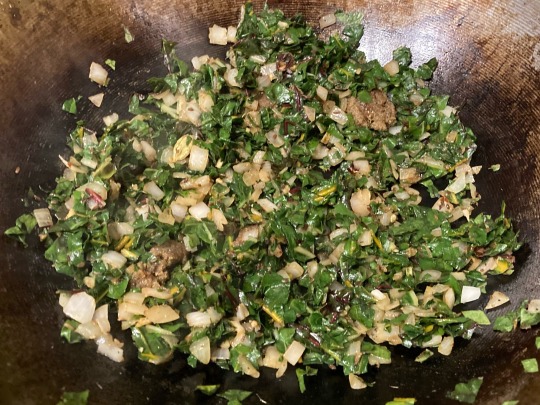
Wilted chard in a wok.
4. Add sumac mixture, chickpeas, and water to cover. Bring to a boil, then lower heat to a simmer. If you didn't steam your seitan earlier, add it now.
5. Continue to stir and simmer until the stew is thick, homogenous, and greyish-brown, about 15 minutes.

Simmered stew.
6. Add the remainder of the garlic mixture, the red tahina, a pinch of ground cumin, the 1/4 cup olive oil, and salt to taste. Return the steamed and seared seitan to the pot and mix.
Serve cool with flatbread, sweet green peppers, bitter green and black olives, carrots, leafy greens, and/or pickles.
#vegetarian recipes#vegan recipe#vegan cooking#Palestinian#Gazan#chickpeas#lamb#seitan#chard#dill seeds#pomegranate molasses
475 notes
·
View notes
Photo
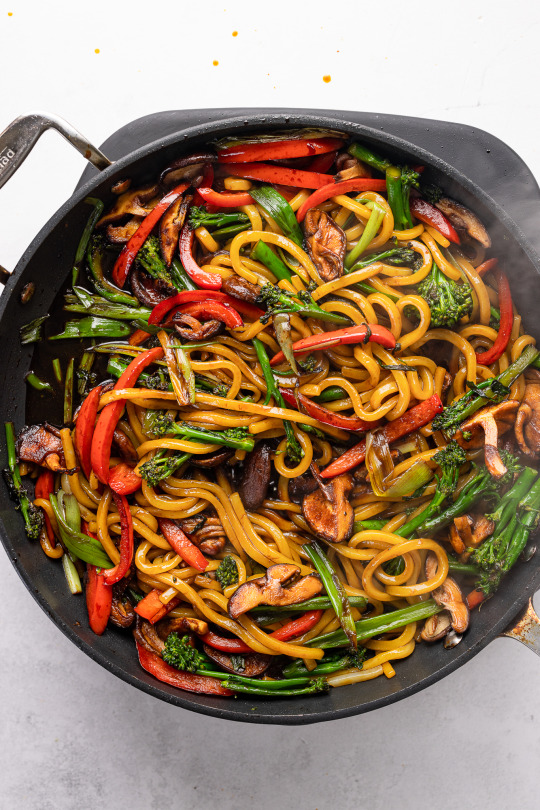
Vegan Yaki Udon
#vegan#food#recipe#vegan food#vegan recipe#vegan recipes#lunch#supper#yum#yummy#delicious#food porn#recipes#veganism#plant based diet#dairy free#egg free#submission
549 notes
·
View notes
Text
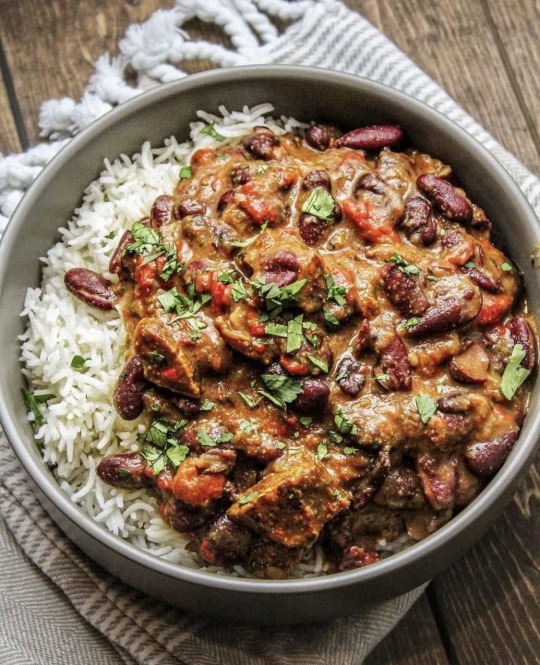
Red beans and rice (vegan)
#red beans and rice#red beans and rice recipe#vegan red beans and rice#vegan red beans and rice recipe#red beans#rice#vegan#vegan recipe#vegetarian#vegetarian recipe#plant based#plant based recipes#dinner#dinner recipes#food#food blog#recipe#dinner ideas
155 notes
·
View notes
Text
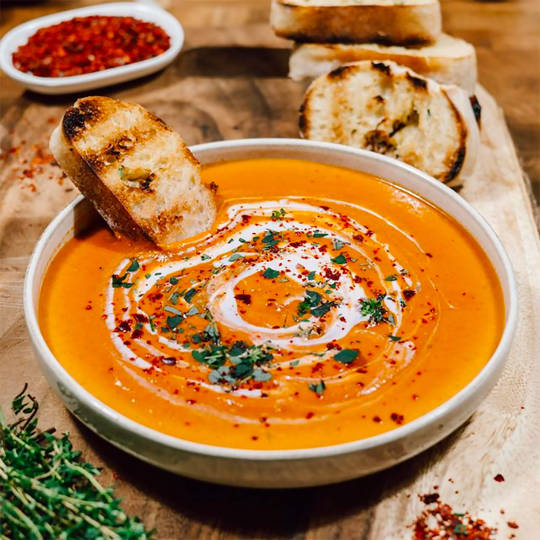
Tomato soup lovers rejoice! 🍅 This version roasts and sautés all the ingredients to lock in deep flavors with hints of ginger and maple syrup, finished with super creamy soy skyr, a thick filtered yogurt 🍂🍁
#tomato#tomato soup#veganrecipes#plantbased#vegan#veganrecipe#plantbasedrecipes#plantbasedrecipe#veganism#plantbased recipes#vegetarian#go vegan#vegan soup#vegan recipes#vegan recipe#vegan cooking#vegan food#veganfood#gluten free#veggies#spices#baked vegetables#sautéed#creamy soup#fall food#autumn#fall vibes#fall recipes
165 notes
·
View notes
Text
Let's Matcha 🍵
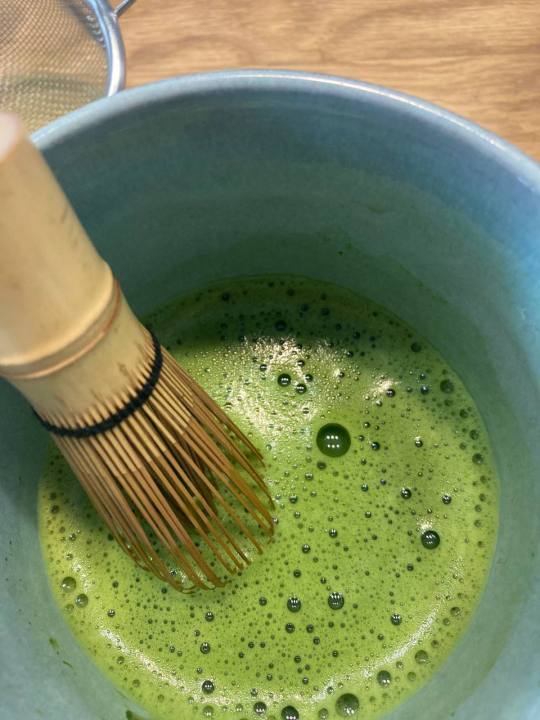
1. What is required:
matcha
soy milk or any other plant-based milk
35-40 ml hot (not boiled!) water
10-15 ml maple syrup (optional)
a chasen, a wooden whisk, or a hand mixer (a must)
a small sifter (almost a must)
a matcha bowl and a chashaku, a tea scoop (not a must at all 😉)
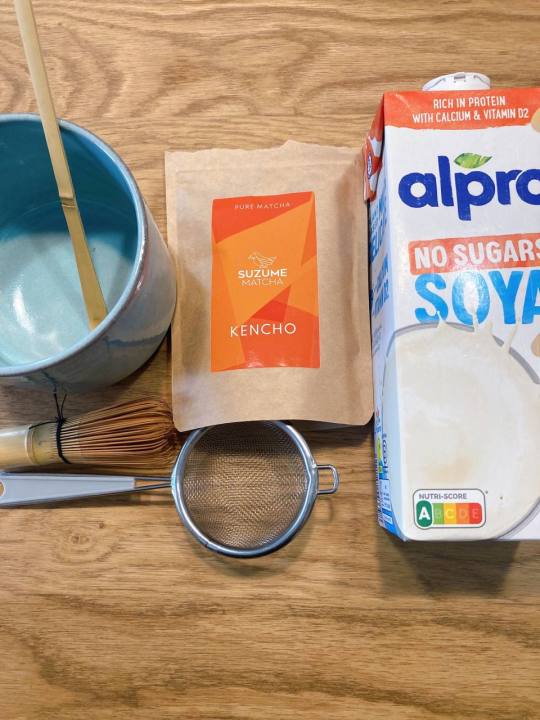
2. Scoop 2-3 g. of matcha and sift through. It's required to avoid bigger clumps in a drink.
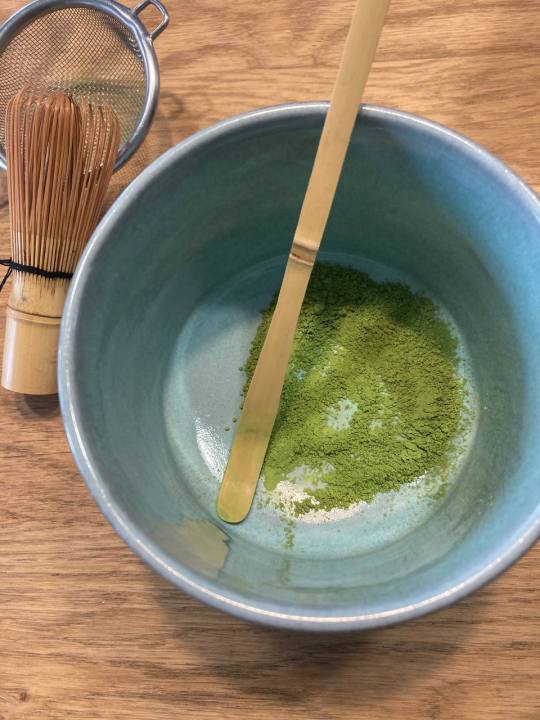
3. Pour hot water and whisk vigorously. You should get a very nice smooth frothy matcha. If you don't have a sifter, whisk even more vigorously 😅 If you want, you can add a maple syrup and whisk it all together. I prefer plain matcha, but if it's your first try, drink with and without a sweetener to see what your preference is.
Look at the colour! No filter.

4. Pour matcha to a glass or a cup, add the mix of water and soy milk to your taste. It's very subjective and depends on your taste. Soy or oat milk makes it rich and creamy and water makes it less bold and intense as matcha does have a very strong taste. If it's too hot, add ice cubes.

I am ready to enjoy my matcha, carrot cake, and the book on the balcony ���️
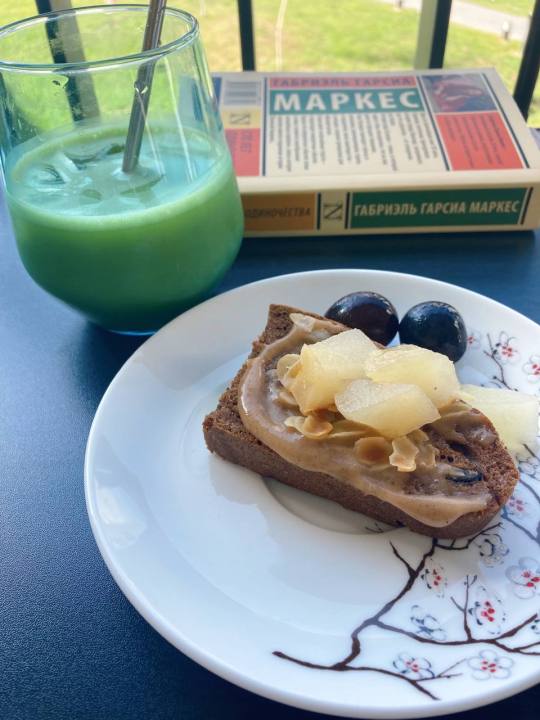
My goal is to make as many various matcha drinks as I saw in one Matcha House in Warsaw


#vegan#veganism#vegan food#vegans#plant based#food#foodie#what vegans drink#matcha#vegan matcha#soy milk#recipe#vegan recipe
86 notes
·
View notes
Text
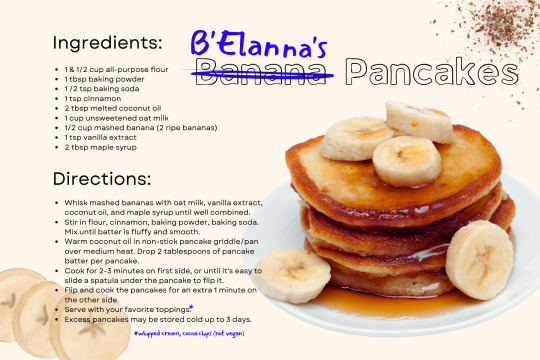
She remembered the smell of the coconut oil in the black cast-iron skillet. The sound of it catching fire. The sparks like fireflies in the backyard.
She remembered the feel of the fork as she mashed the banana. The best ones had black spots, just overripe but not too wet, not too sweet. It was her job to press the fruit into a paste. The first ingredient to go in the bowl. 'The foundation of the recipe', that’s what her grandmother called it. "Breakfast is built on this banana. Today is built on breakfast. Your life, B’Elanna, is built on today."
They added the other ingredients on top of the mashed banana paste. She pretended it was the weather. A maple syrup flood. Flour snow. Mixed all together in a baking tornado. Then added to the pan, three at a time. More than once she was too impatient and when the pancakes flipped they fell apart in a banana mash-flour snow-oat milk ribbon mess.
But even the ugly ones tasted like home.
She handed the fork to Miral. Carefully showed her how to mash the fruit. Grinned when the child decided to do it her own way. Just like Tom. Just like her.
They created weather together. They made sparks like fireflies. They measured out three pancakes at a time. And they flipped them too soon. But even the ugly ones tasted like home.
"Breakfast is built on a banana," she told her daughter. "Today is built on breakfast. And your life, Miral, your whole beautiful life, is built on today."
Miral touched her fat, wet, banana-mush-covered hand to B’Elanna’s cheek.
Today was perfect.
written for @startrekpotluck 2023, day 7
#startrekpotluck2023#b'elanna torres#miral paris#belanna torres#belanna pancakes#banana pancakes#recipe#star trek voyager#vegan recipe#vegan pancakes
72 notes
·
View notes
Text

45 notes
·
View notes
Photo
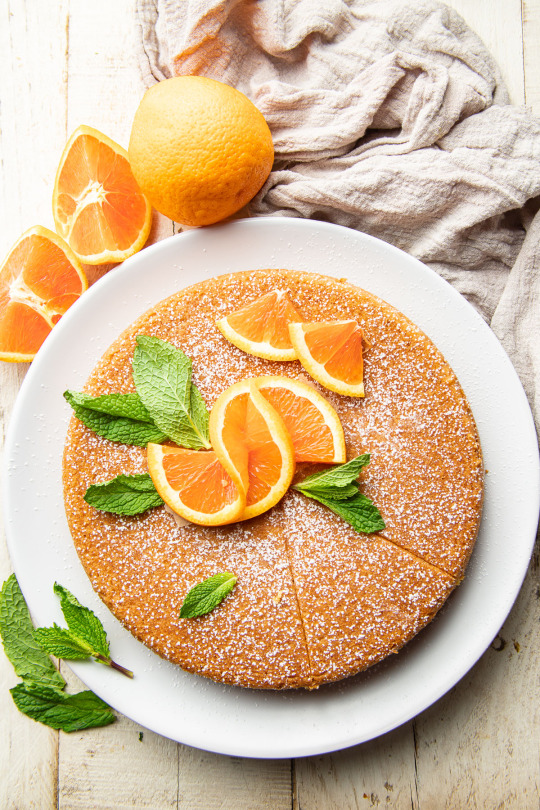
This vegan orange olive oil cake is super moist and intensely flavorful! It's a simple yet elegant dessert that's super easy to make. You only need one bowl and no electric mixer! Recipe: https://www.connoisseurusveg.com/vegan-orange-olive-oil-cake/
95 notes
·
View notes
Text
Vegan Cream of Mushroom Soup
#vegan#food#vegetarian#vegan food#veganism#recipe#plantbased#dinner#vegan recipe#vegan soup#soup recipe#mushroom soup#fall#fall recipes
391 notes
·
View notes
Text

Daigaku Imo (Japanese Candied Sweet Potatoes)
#okonomikitchen#asian#recipe#recipes#potato#japanese#japanese food#asian food#japanese recipe#japanese recipes#sweet potato#daigaku imo#snacks#savoury#vegan recipe#vegan recipes#vegan#veganism#vegetarian#glutenfree#gluten free#sweet potatoes
891 notes
·
View notes
Text
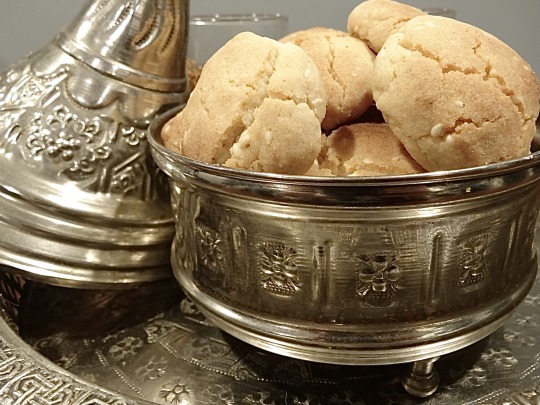
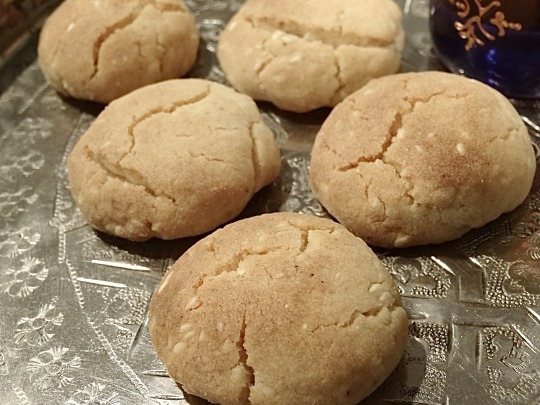
[ID: First image shows small cookies with cracked surfaces in a silver tin with pointed lid embossed with geometric designs; second image shows the same cookies on an engraved silver tray with a tea glass in the background. End ID]
غُريبة لبهلة / Ghriba l'behla (Moroccan shortbread cookies)
Ghriba l'behla (literally, "strange silly"), a popular teatime cookie, are perhaps so named because of the distinctive cracks that form on the surface of the cookies as they rise. Cookies without these distinctive cracks may be ghriba, but they are not ghriba l'behla. The melt-in-your-mouth, crumbly texture of ghriba is traditionally achieved with a 4 : 1 : 1 ratio of flour : sugar : oil.
Ghriba l'behla are commonly made with a specialized mold that gives them a concave bottom, thins them out around the edges, and causes them to crack more dramatically—the underside of a Dutch pancake pan or a mini idli tray would work for this purpose, but ghriba may also be made with a flat cookie sheet.
Though they may be made plain, ghriba are often flavored with toasted sesame, cinnamon, almonds, orange blossom water, and even lemon or orange zest. This recipe is for sesame-cinnamon ghriba, but you may also press an almond into the center of each cookie, coat them in powdered sugar, or add a couple teaspoons of orange blossom water or brine from a jar of Moroccan preserved lemons.
Recipe under the cut!
Patreon | Tip jar
Ingredients:
About 3 cups (360 - 390g) all-purpose flour
1/2 tsp fresh yeast (optional)
1/2 cup (70g) hulled sesame seeds, divided
1/2 cup (118mL) vegetable oil
1/2 cup vegan margarine or shortening, melted
3/4 cup (150 grams) vegetarian granulated sugar
Pinch of salt
1/4 tsp ground cinnamon
2 tsp baking powder
Instructions:
1. In a dry skillet over medium heat, toast sesame seeds until they are fragrant and a shade darker. Coarsely grind about half of the toasted sesame seeds in a mortar and pestle or spice mill. Set aside.
2. Melt margarine or shortening in a microwave or on the stovetop. Add sugar and stir to dissolve.
3. Combine margarine mixture and all other ingredients except for four in a large mixing bowl. Add flour a little at a time to make a dry, crumbly mixture that doesn't quite hold together when pressed; you may need more than 3 cups.
4. Knead the dough by hand, or use a stand mixer with the paddle attachment on its lowest setting, for 20 minutes. The dough should appear crumbly, like damp sand, but should now pack into a ball easily when pressed. Add more flour or oil if necessary to achieve this texture, kneading for another few minutes to incorporate.
5. Preheat your oven to 320 °F (160 °C) with the rack in its lowest position. Form the ghriba dough into balls about 3/4” (2cm) in width, packing them together with both hands and then flattening them silghtly between your palms. The edges of the dough should not crack or separate.
If you have a ghriba mold, gently press each ball of dough down over a bump on the mold, pressing down and thinning out the edges slightly to ensure a dramatic, concave bottom.
If you don't have a ghriba mold, place the ghriba on a baking sheet prepared with parchment paper. Make sure to separate them by about an inch, because they will rise slightly.
6. Turn on the broiler and broil the ghriba in the lower rack of your oven for 2-5 minutes, until cracks begin to appear on the surface.
7. Turn the broiler off and move the ghriba to the upper third of the oven. Continue to bake at 320 °F for 3-5 minutes, until very lightly golden brown and not quite firm to the touch.
8. Allow the ghriba to cool for 2 minutes, then transfer them to a wire cooling rack and allow to cool completely. Store in an airtight container.
260 notes
·
View notes
Photo
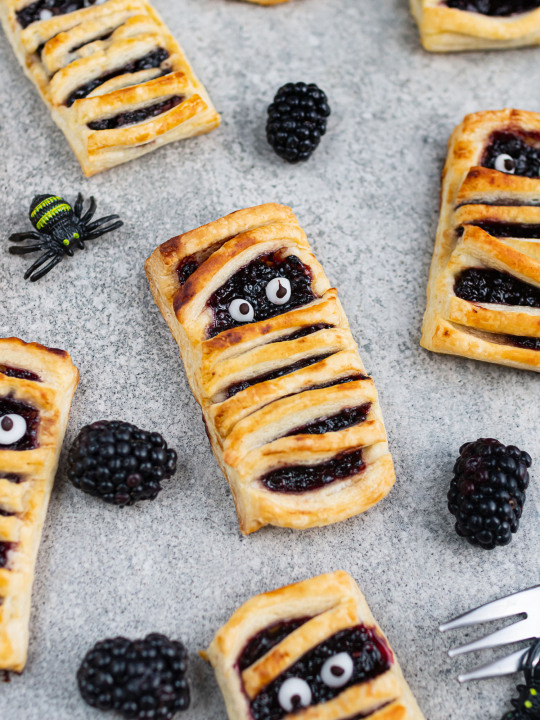
Halloween blackberry mummy pies
You can make these pies with just a few ingredients, and they are adorable, creepy and delicious! They sure are popular among kids! Recipe here 👻
#vegan#recipe#vegan food#vegan recipe#vegan recipes#breakfast#dessert#delicious#plant based#recipes#veganism#plant based diet#dairy free#egg free#submission
204 notes
·
View notes
Text

Roasted chickpea and veggie bowl (x)
#roasted chickpea and veggie bowl#roasted chickpeas#roasted chickpea recipe#roasted veggies#roasted veggie recipe#vegan recipe#vegan#vegan food#vegetarian#vegetarian recipe#vegetarian food#chickpeas#veggies#food#food blog#recipe#dinner#dinner ideas#dinner recipes#yum#food pics
76 notes
·
View notes
Text
Rigatoni tossed in a creamy lemon garlic sauce with fresh basil, topped off with lemon zest. It's simple, fresh and flavorful.

#veganrecipes#plantbased#vegan#veganrecipe#plantbasedrecipes#plantbasedrecipe#veganism#plantbased recipes#vegetarian#go vegan#lemon#creamy pasta#pasta#pasta dish#pasta sauce#vegan pasta#vegan recipes#vegan recipe#plant based recipes#plant based#plantbased recipe#creamy#meal#lunch recipe#lunch#lunchtime#dinner#dinner recipes#lunch recipes
126 notes
·
View notes